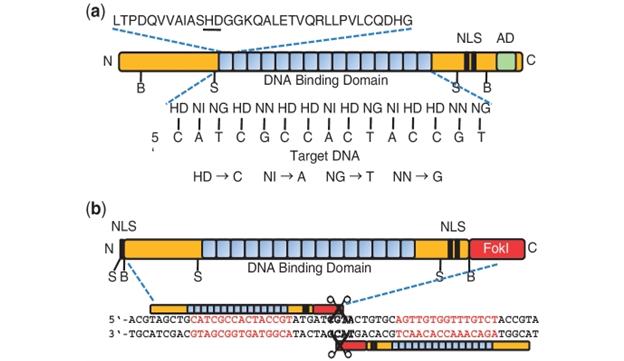Authors: R. Mohammed Aseef* and V. Poobalan
Research Scholar, Horticultural College & Research Institute, Tamil Nadu Agricultural University, Coimbatore, India
*Corresponding author: tnauaseef@gmail.com
TALENs are a protein with two components: The first component is a designed transcription activator-like (TAL) effector (TALE) that mimics the phenomenal natural TAL effector proteins secreted by the plant bacterial pathogen Xanthomonas. The second is a popular nuclease ( FokI) that can cut DNA in cells. TALENs can be used as a tool to site specifically edit the genome of many species. The bacterium Xanthomonas has a needle like structure that can penetrate the plant cell wall to deliver TALE proteins into plant cells. The delivery process is similar to a vaccination, but it is meant to harm the plant. Inside the plant cells, the TALEs from the bacterium work very precisely. It appears that this bacterium evolved a method of controlling the basic mechanism of gene expression and regulation. The expression of any particular gene is normally controlled by the DNA sequence immediately upstream of the gene, called promoter. The promoter sequence functions like a switch for turning on or off the gene downstream. When the promoter is bound with a transcription activator from the plant itself, the gene is turned on and a specific protein is made benefiting the plant. However when the TALE of the Xanthomonas bacterium is inserted into the plant to disrupt the plant defense, the TALEs from the bacterium only bind to the promoter sequence of the susceptibility genes that are master regulators of many other decrease responsive genes. Thus the Xanthomonas bacteria exploit the plant own gene expression/regulation mechanism for its own benefit.
There are tens of thousands of genes in plant genome. Therefore, what guides the TALEs from Xanthomonas to bind to the promoter sequences of the master susceptibility genes without missing the targets? To resolve this mystery, scientists have recently sequenced the genes encoding TALEs and uncovered the molecular structure of TALEs (Fig. 1). This work shows that the TALE proteins contain a nuclear localization signal (NLS), a transcriptional activation domain (AD) and a DNA binding domain (Fig. 1). The NLS allows TALEs to enter the nucleus inside a plant cell while the AD domain stimulates the transcriptional machinery for transcription or gene expression. Since the TALE functions to bind to DNA, the DNA binding domain is the most logical place concealing the mystery of guiding TALEs to their target, the master susceptibility genes (Fig. 1).

| Fig 1: a) A typical structure of TALEs containing a nuclear localization signal (NLS), a transcriptional activation domain (AD) and a DNA binding domain. The DNA binding domain comprises multiple repeats that are identical except for their two signature amino acids near the middle. To name the repeats, the two signature amino acids are conveniently used. For example, the first repeat is named as HD (histidine, aspartic acid). For each repeat, the two signature amino acids specify which DNA base (A, T, G or C) to bind. The rule governs the binding is simple, i.e. repeat HD binds to base C, repeat NG (asparagine, glycine) to T, repeat NN (two asparagines) to G and repeat NI (asparagine, isoleucine) to A [Adapted from Cermak et al., 2011]. b) The structure of the designed TALENs |
There are many repeat units that vary slightly in the DNA binding domain, and each repeat unit follows a simple rule to specifically bind to one of four DNA bases A, C, G and T (Fig. 5). This is similar to an array of keys assigned with a specific letter on a keyboard for typing. Therefore, the content, number and order of the repeats in the DNA binding domain determine the specific binding site of TALEs.
The greatest lesson that nature has taught us here is the simple rule of “one repeat unit binds to one DNA base”. It is this simple rule that allows us to mimic the Xanthomonas TALe’s and design and engineer our own TALEs for binding to a site we want in the genome. It is also this simple rule that allows us to combine the TALEs we design with a nuclease that cuts DNA to create TALE nucleases (TALENs).
TALENs can be used to improve resistance to most other diseases in plants. In fact, TALENs are a tool that is very versatile, and using it for improving crop quality, yield and stress tolerance is very feasible. Looking forward, growers of apples, berries, grapes and many other fruit crops will spray much less for disease control while harvesting more high quality fruits.
References:
Cermak T, Doyle EL, Christian M, Wang L, Zhang Y, Schmidt C et al. Efficient design and assembly of custom TALEN and other TAL effector-based constructs for DNA targeting. Nucleic Acids Research 2011; 39:82.
About Author / Additional Info: